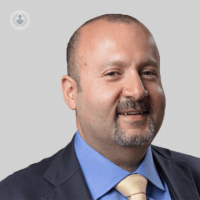Your quick recovery guide to strains, sprains and breaks
Written in association with:Injuries to joints, muscles, ligaments and bones happen to us all at some point. As we grow older, we grow more cautious of our surroundings and potentially harmful situations. However, there are times when these situations are either unavoidable or take us by surprise – that’s when injuries occur.
Professor Ali Ghoz, a consultant trauma and orthopaedic surgeon based in London, explains how to effectively manage these injuries, also known as orthopaedic trauma.

What is orthopaedic trauma?
Orthopaedic trauma refers to an injury to any soft tissues or bones. It can be divided into two distinct sections: bone trauma and soft tissue trauma.
Bone trauma refers to fractures and dislocations and soft tissue trauma includes injuries to muscle, tendons, ligaments and nerves.
What can cause orthopaedic trauma?
The most common causes are:
- Trips and falls
- Sporting injuries
- Car accidents
- Cycling accidents
Multiple injuries can occur in any of these situations which is known as polytrauma. This is when a patient has been subjected to multiple traumatic injuries, usually from high energy impact, such as skiing accidents, a fall from a height, car accidents, etc.
How is trauma treated?
Each condition is treated depending on the type of injury.
- Soft tissue trauma
The treatment for this type of injury depends on the severity. If the injury is a sprain or contusion then first aid should initially be given, that will involve the RICE protocol straight after the injury occurs to prevent further damage – Rest, Ice, Compression and Elevation.
Sometimes rest is enough for the injury to heal, other times physiotherapy is recommended as further treatment. If the injury is severe or persistent, surgical intervention might be required.
- Bone trauma
Sometimes, a period of rest and elevation is sufficient for the injury to heal however, if there’s a break or a fracture, a splint or cast may be required. This will be in the form of a period of immobilisation. For upper limb fractures, the immobility period lasts around four to six weeks and for lower limb fractures this can be between six to eight weeks.
Surgical intervention is sometimes required in displaced, or unstable fractures. This would involve stabilisation of the fracture, either through the use of a plate and screws or an intramedullary rod to reduce and stabilise the fracture.
How long does recovery take and what can be expected during recovery?
The recovery period depends on the type of injury you have.
- Soft tissue injury
If there’s been no surgery involved, you can expect soft tissue damage to take between four to six weeks to heal. This can take longer if there’s extensive soft tissue damage. During this time, you can expect some pain and swelling around the injured area.
To manage the swelling you can apply topical creams and take anti-inflammatory medication, depending on your allergy status. You are expected to rest to allow the soft tissues to heal. Once the soft tissues have settled down, you should aim to do physiotherapy and build up your strength in the affected area.
If there is evidence of nerve damage, it can take up to 24 months to recover and physiotherapy is more than likely to be required for this type of injury.
- After surgery
If surgery has been done to reconstruct any ligaments or repair any tendons, you can expect to make a recovery within six months. During this period, you will initially need to rest followed by physiotherapy.
- Fractures
Depending on the type of fracture, usually a period of immobility will last between six to eight weeks. After immobilisation, then physiotherapy is usually required.
During the period of rehabilitation, the healing of the fractured bone will be watched closely by an orthopaedic surgeon and sometimes surgical intervention is required to stabilise displaced or unstable fractures.
The initial recovery period of a fracture is six to eight weeks however, the actual fracture takes between 12 and 18 months to fully consolidate.
How can I reduce the risk of orthopaedic trauma injuries?
During sporting activities or exercise, you need to make sure you are warming up beforehand to loosen the joints and increase blood flow to the muscles. Exercising regularly will also increase your muscle strength and help maintain flexibility, which in the long term, will help prevent injuries to ligaments, tendons, cartilage and bones.


Before professional sporting events, players often go to pre-rehab to prevent injuries. The purpose of this is to prevent injury before it happens.
Protective gear and uniforms are required in most sporting activities, for instance, if you are on a motorcycle, ensure you are always wearing a helmet and the correct protective gear at all times. If you are on a bike, then a high visibility jacket, as well as a helmet are important to increase your visibility.
It’s very important to be aware of dangerous situations and take the necessary precaution to avoid injuries.
If you need to see an orthopaedic specialist about an injury, visit Professor Ghoz’s profile and book an appointment with him.


